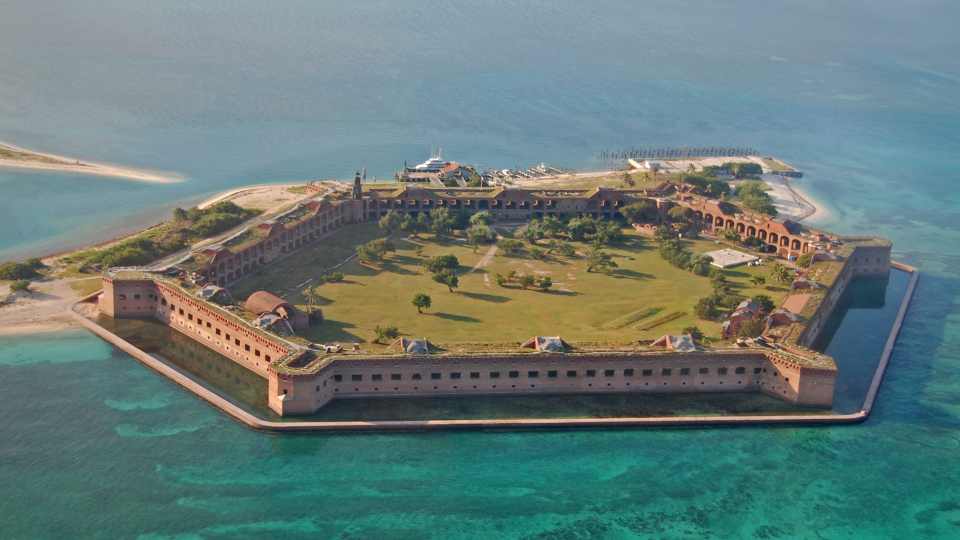
Fort Jefferson is a monumental structure within Dry Tortugas National Park, located in the Gulf of Mexico, 70 miles west of Key West, Florida. The fort stands as the largest brick masonry structure in the Americas and is composed of over 16 million bricks.
Constructed between 1846 and 1875, this massive coastal fortress was designed not only as a military defense but also as a safe harbor for ships. It was part of a larger network of forts established to protect the United States’ southern coastline and its strategic interests in the Gulf of Mexico.
Dry Tortugas National Park encompasses the fort and a cluster of seven small islands, known for their abundant marine life, coral reefs, and migratory bird populations. The area is named for the lack of fresh water (‘Dry’) and the abundance of sea turtles (‘Tortugas’) encountered by early explorers.
Fort Jefferson, despite its remote location, has played various roles throughout history, including acting as a prison during the Civil War era. It’s a testament to the engineering efforts of the 19th century and remains a site of historical and ecological significance.
History of Fort Jefferson
Fort Jefferson stands as a monumental coastal fortress within the Dry Tortugas National Park in Florida. It represents one of the most impressive masonry structures in the Americas, with a storied past that reflects its strategic military significance.
Construction and Purpose
Construction of Fort Jefferson began in 1846, motivated by its potential to control one of North America’s most strategic deepwater anchorages. The design aimed to protect U.S. shipping lanes and the Gulf Coast, particularly from pirate threats. Remarkably, over 16 million bricks were used in the construction, claiming the title of the largest brick masonry structure in the Americas.
Military Significance
The fort’s military value was evident, serving as a deterrent to potential threats by being an advance post for U.S. naval operations. Its strategic location allowed for control over the crucial shipping passage between the Gulf of Mexico and the Atlantic Ocean, serving both commercial and defense interests.
Civil War Era
During the Civil War, Fort Jefferson remained in Union hands, which was vital due to its location. It was used as a prison for deserters and, most notably, for four men implicated in President Abraham Lincoln’s assassination.
Postbellum Era
After the Civil War, the fort’s role shifted from a defensive outpost to a quarantine station and a coaling and re-supply station for warships. However, by the end of the 1800s, Fort Jefferson’s significance waned, leading to its eventual abandonment as a military installation.
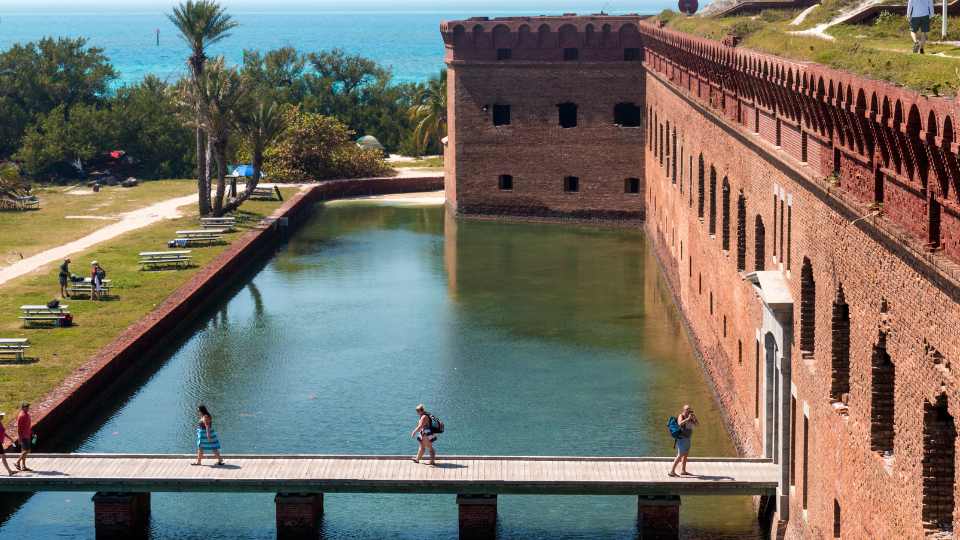
Geography of Dry Tortugas
The Dry Tortugas are a small, remote group of islands located in the Gulf of Mexico known for their distinctive geological makeup and significant maritime location.
Location
The Dry Tortugas are situated approximately 70 miles west of Key West, Florida. This cluster of islands lies along the western perimeter of the Florida Platform, a large carbonate platform that supports the archipelago’s foundation.
Island Composition
These islands predominantly consist of coral and sand. They form part of the extensive coral reef system, known to be the third-largest in the world. The Dry Tortugas comprise seven islands:
- Garden Key
- Loggerhead Key
- Bush Key
- Long Key
- Hospital Key
- Middle Key
- East Key
Each island has a unique composition, predominantly marine sediments and coral reefs, contributing to the park’s extraordinary biodiversity.
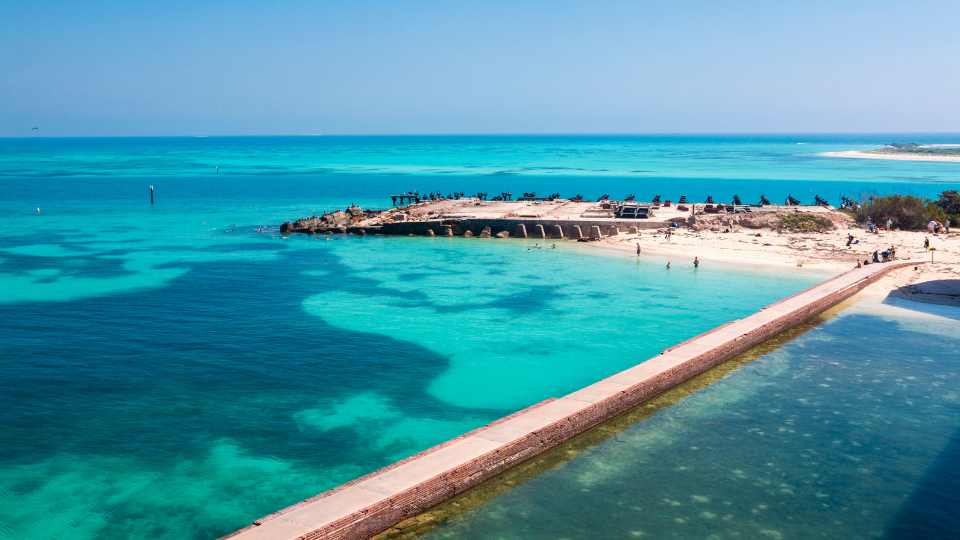
Fort Jefferson Architecture
Fort Jefferson stands as a monumental example of 19th-century military engineering and design. Its massive size and intricate detailing speak to its intended role as a coastal fortress.
Design Features
Fort Jefferson is recognized as the largest brick masonry structure in the Americas, with a staggering count of over 16 million bricks. The fort’s design includes a unique combination of utilitarian military structures and the classical architectural features that were prevalent during its time of construction. Its layout is a geometric hexagon, which allowed for superior defense coverage and the ability to withstand harsh sea conditions.
Defensive Structures
The defensive power of Fort Jefferson was to be provided by two tiers of gun rooms, projecting an impressive field of fire over the strategic waters. These gun rooms were encircled by thick walls, designed to endure bombardment. The fortress also incorporated a large central parade ground, which was essential for military training and operations. Despite these formidable features, it’s notable that Fort Jefferson was never fully armed nor did it face attack.
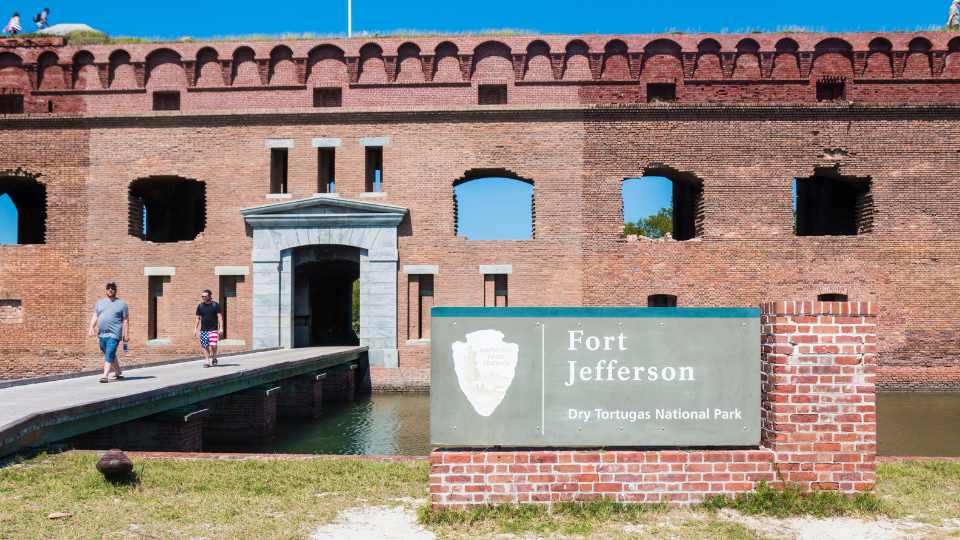
Dry Tortugas National Park
Dry Tortugas National Park preserves a cluster of seven islands and Fort Jefferson, a historical fortress and former prison, marking its position in maritime history and conservation.
Establishment
Dry Tortugas National Park was established by an Act of Congress in 1992. The park is located about 68 miles west of Key West, Florida, and covers approximately 100 square miles. The area is renowned for its natural and historical resources, including the largest masonry structure in the Americas, Fort Jefferson, which serves as a symbol of American ingenuity and engineering.
Conservation Efforts
Dry Tortugas National Park is a critical habitat for an array of seabirds, marine life, and coral reef systems. Management plans focus on:
- Protecting the sensitive coral reef ecosystems
- Monitoring bird populations
- Preserving Fort Jefferson’s historical structure
- Regulating fishing to maintain sustainable fish populations
Tourism and Recreation
Visitors to Dry Tortugas National Park can experience a variety of recreational activities. Key attractions and activities include:
- Snorkeling and Diving: Exceptional clarity of the surrounding waters offers unparalleled opportunities to explore vibrant coral reefs.
- Birdwatching: The park serves as a prime location for spotting a variety of tropical seabirds.
- Camping: Limited camping is available on Garden Key, offering a unique overnight experience.
- Historic Tours of Fort Jefferson: Touring the fort provides insight into its Civil War-era history and architectural significance.
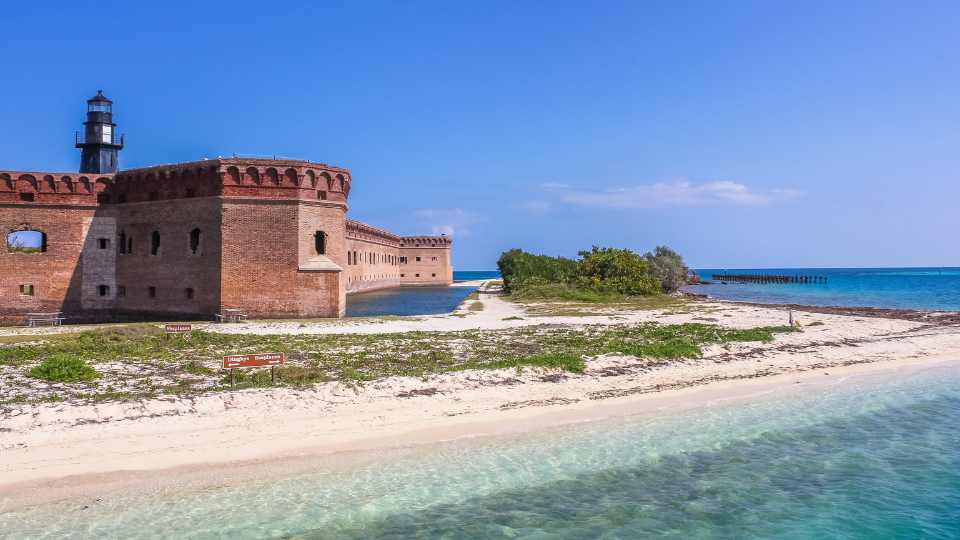
How to get to Fort Jefferson
Since it’s situated on a remote island, the primary ways to get there are by boat or seaplane. Here’s how you can visit Fort Jefferson:
-
Seaplane: This is the fastest way to get to Fort Jefferson. Seaplane trips are offered by a few companies operating out of Key West. The flight is scenic and takes approximately 40 minutes. It typically includes a few hours on the island, giving you time to explore the fort, snorkel, and swim.
- Ferry: There is a daily ferry service from Key West to Fort Jefferson, which takes about 2.5 hours each way. The ferry provides a full day trip, including time to tour the fort, have lunch, and enjoy the beaches and snorkeling.
- Private Boat: If you have access to a private boat, you can make your own way to the Dry Tortugas. Keep in mind that the waters can be tricky to navigate, so make sure you are prepared and experienced in open water navigation. Upon arrival, you will need to pay an entrance fee to the national park.
- Chartered Boat: You can charter a boat from Key West for a private trip to the Dry Tortugas and Fort Jefferson. This option is more flexible but also more expensive.
-
Kayak or Sailboat: For the truly adventurous (and experienced), it is possible to kayak or sail to Fort Jefferson. This is a multi-day expedition requiring careful planning, as the waters of the Gulf of Mexico can be unpredictable and challenging.
Before you go, remember to check the National Park Service website or contact the ferry or seaplane services for the most current information regarding schedules, fees, and any travel advisories. It’s also essential to book your trip in advance, especially during peak tourist seasons, as the seaplane and ferry services have limited daily capacities.
